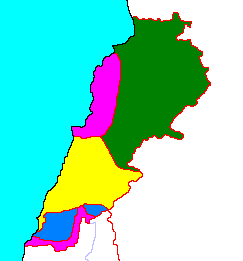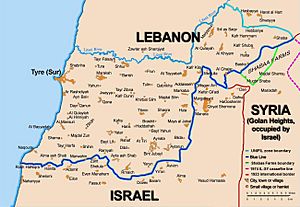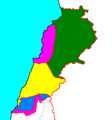Israeli–Lebanese conflict facts for kids
Quick facts for kids Israeli–Lebanese conflict |
|||||||
|---|---|---|---|---|---|---|---|
| Part of Arab–Israeli conflict and Iran–Israel proxy conflict | |||||||
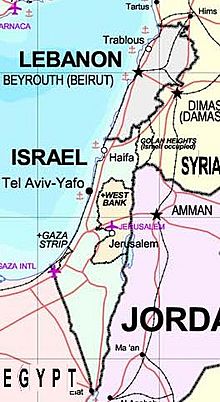 Israel and Lebanon (regional map) |
|||||||
|
|||||||
| Belligerents | |||||||
|
|
|
||||||
| Casualties and losses | |||||||
| 1,000–1,900 killed Lebanese factions 11,000 killed Palestinian factions |
1,400 killed IDF 954–1,456 killed SLA |
||||||
| 191+ Israeli civilians killed 5,000–8,000 Lebanese civilians killed Lebanese sources: 15,000–20,000 killed, mostly civilians |
|||||||
The Israeli–Lebanese conflict is a series of military clashes involving Israel, Lebanon, Syria, the Palestine Liberation Organization (PLO), and various armed groups within Lebanon. This conflict was most intense in the 1980s, during the Lebanese Civil War. It has become much calmer since the 2006 Lebanon War.
The Palestine Liberation Organization (PLO) began recruiting fighters in Lebanon. These fighters were often Palestinian refugees who had left their homes after Israel was created in 1948. After the PLO leadership was forced out of Jordan in 1970–71, they moved to Southern Lebanon. This led to more violence both within Lebanon and across its border with Israel.
At the same time, disagreements over how power was shared in Lebanon led to the Lebanese Civil War (1975–1990). The PLO's actions were a major cause of this war. Their battles with Lebanese groups also led to other countries getting involved.
Israel invaded Lebanon in 1978 to push the PLO away from its border. However, the PLO continued its attacks. Israel invaded Lebanon again in 1982, working with Lebanese Christian militias. They successfully forced the PLO out of Lebanon.
In 1983, Israel and Lebanon tried to make peace with the May 17 Agreement. But this agreement failed in 1984 when other armed groups took control in Lebanon. Israel then pulled most of its troops out in 1985. It kept a small "security zone" in southern Lebanon, helped by a local group called the South Lebanon Army (SLA).
In 1985, Hezbollah, a Lebanese group supported by Iran, started fighting to end Israel's presence in Lebanon. When the Lebanese Civil War ended, most groups disarmed, but Hezbollah and the SLA did not. Fighting with Hezbollah weakened Israel's resolve. This led to the collapse of the SLA and Israel's full withdrawal in 2000 to the UN-recognized border.
Hezbollah continued cross-border attacks, saying Israel still occupied the Shebaa farms territory. Hezbollah also wanted Lebanese people held in Israeli prisons to be released. They captured Israeli soldiers to use them as a bargaining chip for prisoner exchanges. Capturing two Israeli soldiers in 2006 started the 2006 Lebanon War. The ceasefire for this war called for Hezbollah to disarm and for both sides to respect Lebanon's borders.
Fighting stopped on September 8, 2006. Since then, the situation has been mostly calm. However, both sides have broken the ceasefire. Israel flies over Lebanese territory almost daily, and Hezbollah has not disarmed.
Contents
- Understanding the Conflict's Roots
- Key Events in the Conflict
- After the 2006 Lebanon War
- Ongoing Issues in the Conflict
- Images for kids
- See also
Understanding the Conflict's Roots
How Borders Were Formed
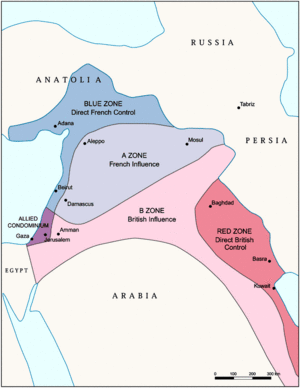
The lands that are now Israel and Lebanon were once part of the Ottoman Empire. This empire lasted from 1299 until it was defeated in World War I. After the war, in 1917, the British took control of Palestine and parts of what is now Syria. French troops took Damascus in 1918.
In 1920, the League of Nations officially gave France control over Syria and Britain control over Palestine. This was based on a 1916 agreement called the Sykes–Picot Agreement.
The Christian-majority area of the French Mandate became the Lebanese Republic in 1926. Lebanon became independent in 1943, but French troops fully left only in 1946.
The Creation of Israel and Refugees
During World War II, many Jewish people moved to Palestine because of anti-Semitism in Europe. This area was mostly Arab with a smaller Jewish population. The British, who controlled Palestine, started to rely on Jewish police to keep order.
This led to more tension and violence between Arabs and Jews. The British decided to leave in 1947. The United Nations General Assembly then proposed a plan to divide Palestine into separate Arab and Jewish states. However, the Arabs rejected this plan, and a civil war began.
Key Events in the Conflict
The 1948 Arab–Israeli War
In 1948, Lebanon had a very small army of only 3,500 soldiers. Other Arab leaders asked Lebanon to join them in invading Palestine. Lebanon sent 1,000 soldiers. The Arab armies waited for the British to leave on May 15, 1948.
Israel declared its independence on May 14, 1948. The next day, the British Mandate ended. The Arab League, including Lebanon, announced their goal to create a "United State of Palestine." Egypt, Lebanon, Syria, Transjordan, and Iraq declared war on the new state of Israel.
The Lebanese army entered northern Galilee. But Israeli forces pushed them back and occupied South Lebanon. Israel signed armistice agreements with its neighbors. The agreement with Lebanon was signed on March 23, 1949. Israeli forces then pulled back to the international border.
After this war, about 711,000 Palestinian Arabs left Israel and went to neighboring countries. By 1949, 110,000 Palestinian Arabs were in Lebanon. They lived in camps set up by the United Nations Relief and Works Agency for Palestine Refugees in the Near East.
Lebanese Christians worried that the arrival of so many Muslims would change the balance of power in Lebanon. So, they placed restrictions on Palestinian refugees. Refugees could not work, travel, or take part in political activities.
The Rise of PLO Fighters (1968–1975)
The Palestine Liberation Organization (PLO) started in 1964. It aimed to create a Palestinian state. From 1968, the PLO began launching attacks from Lebanon into Israel. Israel responded with attacks on Lebanese villages. This was to encourage the Lebanese people to deal with the PLO themselves.
After an Israeli airline was attacked at Athens Airport, Israel raided the Beirut International Airport in 1968. They destroyed 13 civilian planes.
Lebanese citizens could not remove the armed foreign fighters. The Lebanese army was too weak. Palestinian camps came under PLO control after clashes in 1968 and 1969. In 1969, the Cairo Agreement allowed refugees to work, form their own committees, and engage in armed struggle. The PLO took over managing the refugee camps.
In 1970, the PLO tried to overthrow King Hussein of Jordan. After he stopped the rebellion, the PLO leaders and their fighters moved from Jordan to Lebanon. This led to more violence across the border.
With its main office in Beirut, the PLO recruited new members from Palestinian refugee camps. Southern Lebanon became known as "Fatahland" because Yasser Arafat's Fatah group was so strong there. The PLO had its own army in Lebanon, creating a "state within a state." By 1975, over 300,000 Palestinian refugees lived in Lebanon.
In 1973, Israel carried out Operation Spring of Youth. Israeli Special Forces landed in Lebanon and, with help from Israeli intelligence, assassinated several PLO leaders in Beirut.
The Lebanese Civil War (1975–1990)
The Lebanese Civil War (1975–1990) was a complicated conflict. Many groups fought each other, including Lebanese Christians, Muslims, Palestinian Muslims, and Druze. Power in the government was divided among different religious groups. Changes in population and feelings of unfairness by some groups, along with Israeli–Palestinian clashes in the south, all led to the war.
Israel's Support and Early Operations
From May 1976, Israel began supplying arms and military advice to Christian militias in Lebanon, like the Lebanese Forces. The border between Israel and Lebanon was called the Good Fence at this time.
In March 1978, PLO fighters attacked a bus in Israel, killing many civilians. In response, on March 14, 1978, Israel launched Operation Litani. About 25,000 Israeli troops occupied southern Lebanon. The goal was to push the PLO away from the border and support a Lebanese Christian militia called the South Lebanon Army (SLA).
The United Nations Security Council passed Resolution 425 on March 19, 1978. It called for Israel to withdraw immediately and for a United Nations Interim Force in Lebanon (UNIFIL) to be set up. When Israel withdrew later in 1978, it handed its positions to the SLA. The SLA continued to fight the PLO as Israel's ally.
The 1982 Lebanon War
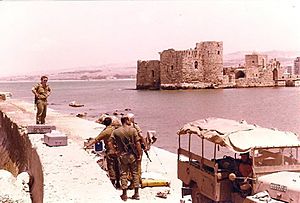
The 1982 Lebanon war began on June 6, 1982. Israel invaded again to attack the Palestine Liberation Organization. The Israeli army surrounded Beirut. During this conflict, between 5,000 and 8,000 civilians were killed, according to some reports.
Fighting also happened between Israel and Syria. The United States helped arrange a ceasefire on August 12. The PLO leaders left Beirut on August 30, 1982, and moved to Tunisia.
After the war, Lebanon's parliament chose Bachir Gemayel as president. But he was assassinated on September 14, 1982. Israel then reoccupied West Beirut.
Peace Attempts and Withdrawal
In 1983, the United States helped create the May 17 Agreement. This was a peace treaty between Israel and Lebanon. It called for Israel to withdraw its troops and for a "security zone" in southern Lebanon. However, this depended on Syria also withdrawing its troops.
In August 1983, as Israel pulled back from areas southeast of Beirut, Lebanese groups fought for control of the freed land. In February 1984, the Lebanese Army broke apart. Many units formed their own armed groups. Shia and Druze militias took over much of Beirut. Under pressure from Syria and Muslim militias, Lebanon cancelled the May 17 Agreement on March 5, 1984.
On January 15, 1985, Israel began a phased withdrawal. It finally pulled back to the Litani River to create a 4 to 12 kilometer deep Israeli Security Zone. The South Lebanon Army militia helped Israel control this zone.
The SLA and Hezbollah Conflict (1985–2000)
Hezbollah's Rise to Power
On February 16, 1985, a Shia leader named Sheik Ibrahim al-Amin announced a new group called Hezbollah. Its main goal was to fight the Israeli occupation of Lebanon. During the South Lebanon conflict (1985–2000), Hezbollah fought a guerrilla war against Israeli forces and their South Lebanon Army (SLA) allies.
By the end of 1990, the Lebanese Civil War was mostly over. In March 1991, Lebanon passed a law forgiving all political crimes. In May 1991, most armed groups were dissolved, except for Hezbollah and the SLA. The Lebanese Armed Forces slowly began to rebuild.
Border Conflicts and Israeli Withdrawal
From 1985 to 2000, Israel continued to support the South Lebanon Army. In 1992, Hezbollah won ten seats in the Lebanese parliament.
On July 25, 1993, Israel launched Operation Accountability, also called the Seven-Day War in Lebanon. This was in response to Hezbollah attacks that killed Israeli soldiers in the "security zone." Thousands of buildings were bombed, and 120 people died. 500,000 civilians were forced to leave their homes. Israel also destroyed power stations and bridges. Hezbollah fired rockets into Israel in return. A truce was made, where Israel agreed to stop attacks north of its security zone, and Hezbollah agreed to stop firing rockets into Israel.
On April 11, 1996, Israel started Operation Grapes of Wrath, or the April War. This was after Hezbollah fired rockets into Israel. During this operation, 106 Lebanese people died when a UN compound was hit by Israeli shelling. The conflict ended on April 26, 1996, with a ceasefire. Both Hezbollah and Israel agreed not to attack civilians.
In January 2000, Hezbollah killed Colonel Akel Hashem, who was in charge of SLA operations. In response, on February 7, the Israeli Air Force attacked Lebanon's civilian infrastructure, including power stations.
Israel announced on May 24, 2000, that it would withdraw to the UN-designated border. This happened 22 years after Resolution 425 called for it. The South Lebanon Army's equipment and positions largely fell into Hezbollah's hands. Lebanon celebrates May 25 as Liberation Day.
Border Clashes and Other Events (2000–2006)
- On October 7, 2000, three Israeli soldiers were captured and killed by Hezbollah across the Israeli–Lebanese border.
- On January 29, 2004, a prisoner exchange happened. Many Lebanese and Palestinian prisoners were released from Israeli prisons. In return, Israel received an Israeli businessman and the bodies of the three soldiers captured in 2000.
- In May 2004, Hezbollah fighters killed an Israeli soldier along the border in the Shebaa Farms area.
- Between July and August 2004, there was more intense fighting along the border.
- On September 2, 2004, Resolution 1559 was approved by the UN. It called for all Lebanese armed groups to disarm. Israel saw Hezbollah's armed status as a violation of this resolution.
- Syrian troops left Lebanon in April 2005.
- On May 26, 2006, a car bomb killed Palestinian Islamic Jihad leader Mahmoud Majzoub in Sidon. Lebanon's Prime Minister suspected Israel, but Israel denied involvement. Rockets were fired from Lebanon into Israel on May 28, 2006.
The 2006 Lebanon War
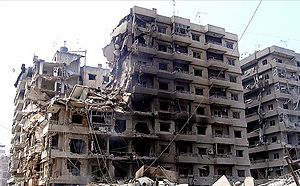
On July 12, 2006, Hezbollah launched rocket attacks on Israeli military positions. Another Hezbollah group crossed into Israel and attacked two Israeli army vehicles. They killed three Israeli soldiers and captured two.
Hezbollah quickly demanded the release of Lebanese prisoners held by Israel in exchange for the captured soldiers. Heavy fighting broke out along the entire Blue Line.
This started the 2006 Lebanon War. Israel responded with massive airstrikes and artillery fire across Lebanon. They also set up air and naval blockades and launched a ground invasion of southern Lebanon. In Lebanon, over 1,100 people died, and about one million people were forced to leave their homes. Israel suffered 42 civilian deaths from rocket attacks.
A United Nations-arranged ceasefire began on August 14, 2006. The blockade was lifted on September 8.
After the 2006 Lebanon War
Since the 2006 war, there have been only a few separate incidents.
Border Incidents Between Armies
- On August 3, 2010, Israeli and Lebanese armies clashed. A Lebanese sniper killed an Israeli officer. Israel responded with air and artillery strikes, killing two Lebanese soldiers. The UN confirmed that Israel had not crossed the border.
- On December 16, 2013, a Lebanese soldier, acting alone, fired at an Israeli naval officer's car, killing him. The soldier later surrendered. Israeli troops then fired at "suspicious movement" on the Lebanese side, hitting two Lebanese soldiers.
Israel-Hezbollah Border Clashes
- On January 18, 2015, an airstrike in Syria killed six Hezbollah members and an Iranian officer. The UN believed Israel was responsible. In response, on January 28, Hezbollah fired missiles at an Israeli convoy in the Shebaa farms area, killing two soldiers. Israel fired shells into southern Lebanon, killing a Spanish peacekeeper.
- On September 1, 2019, Hezbollah launched rockets from Lebanon into Israel. They targeted a military base and an Israeli army vehicle. Israel said no Israelis were wounded.
- On July 27, 2020, Israeli soldiers and four Hezbollah members exchanged fire.
Lebanese Rocket Attacks on Israel
- On June 17, 2007, an unknown group fired two rockets from Lebanon into northern Israel. Hezbollah denied involvement.
- On September 11, 2009, two rockets fell in northern Israel, causing no injuries. Israel fired back at the launch sites.
- On April 25, 2022, a rocket was fired from Lebanon into Israel. Israel responded by firing at targets in Lebanon.
- Between August 4-6, 2023, Israel launched airstrikes in South Lebanon after rocket attacks from Hezbollah. This was the first time Israel used warplanes on Lebanon since 2006.
Israeli Airstrikes in Lebanon
- On February 24, 2014, reports said Israeli warplanes attacked targets near the Syrian-Lebanese border. Some reports claimed the targets were Hezbollah convoys carrying advanced weapons.
- On August 25, 2019, Lebanese officials reported that two Israeli drones crashed in Beirut. One crashed into the roof of the Hezbollah Media Center. This was the first such incident between Israel and Lebanon since the 2006 war.
Aerial Activity and Other Incidents
- On October 6, 2012, an Israeli drone, believed to be operated by Hezbollah, was shot down by the Israeli Air Force in Israel.
- On July 11, 2015, an Israeli drone crashed near Tripoli port in Lebanon and was recovered by the Lebanese Army.
- On October 31, 2019, an Israeli drone was targeted by a Hezbollah anti-aircraft missile in Southern Lebanon. Hezbollah claimed it was shot down, but Israel denied this.
- On February 18, 2022, a Hezbollah drone from Lebanon flew 70 kilometers into Israeli airspace for 40 minutes before returning. Israel's Iron Dome system failed to stop it. Israeli jets flew very low over Beirut in response.
- On December 4, 2013, a Hezbollah Commander, Hassan al-Laqqis, was assassinated in Beirut. Israel denied involvement.
Ongoing Issues in the Conflict
Israeli Flights Over Lebanon
Since the civil war, Israel has often flown planes and drones into Lebanese airspace. This is against international law and violates United Nations Security Council Resolution 425 and 1701.
These flights happen almost daily since the 2006 Lebanon war. They are a major source of tension. Israeli warplanes sometimes perform mock attacks over Lebanese cities, creating loud sonic booms that scare civilians.
In 2007, Lebanon complained that Israeli planes had flown into its airspace 290 times in four months. Lebanese officials worry these flights increase tensions and could lead to another war.
Israel says these flights are necessary. However, a leaked US document showed that Israel offered to stop these violations.
Border Crossings
On land, the Blue Line is often crossed. There are also crossings into the Shebaa Farms area. Israel considers this part of the Golan Heights, which it captured from Syria in 1967. But Lebanon claims it is Lebanese territory. The 2010 Israel–Lebanon border clash happened because of claims of such border violations.
At sea, Israeli gunboats have fired into Lebanese waters. Lebanon also claims Israel might be trying to take its natural resources, like gas fields.
Hezbollah uses these violations as a reason to continue its armed resistance against Israel.
Images for kids
See also
 In Spanish: Conflicto Israel-Líbano para niños
In Spanish: Conflicto Israel-Líbano para niños
- 1958 Lebanon Crisis
- Black September in Jordan
- Cedar Revolution
- 2008 conflict in Lebanon
- Israeli–Palestinian conflict
- List of modern conflicts in the Middle East
- List of rocket attacks from Lebanon on Israel


